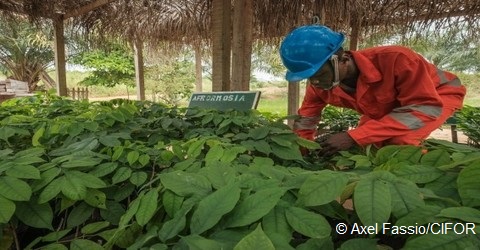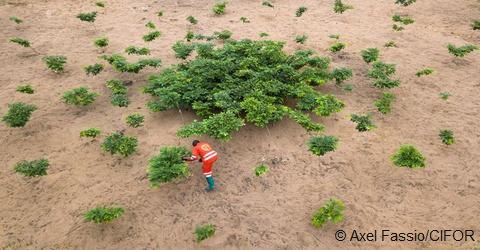Afrormosia (or Assamela, Pericopsis elata) is a hardwood flagship species native to Central and West Africa, and is one of the most harvested and most valuable in the DRC. Thanks to its exceptional properties it is very popular for instance with furniture makers and interior designers and architects (for parquet floors, terraces, window frames etc.)
However, as the trees suffer from regeneration problems, overexploitation may jeopardise the survival of the species. To develop a more sustainable management, researchers are trying to understand the tree's growth pattern through experimental plantations.
To unravel the tree's growth pattern, researchers from the RMCA, CIFOR (Center for International Forestry Research) and R&SD (Resources and Synergies Development) are carefully studying the growth of afrormosia trees on a plantation in Kisangani (DRC). The researchers are using so-called Nelder wheels, an experimental setting where trees are planted in concentric circles. Trees in the centre are very close to each other, and are planted farther away from each other as the radius of the circle expands outwards. In this way, the researchers can assess the impact of distance on the growth and mortality of the trees. This will allow researchers to provide foresters with guidelines on how to efficiently plant seedlings of the species.
"This experiment is of great importance to the logging sector, as it can determine the ideal distance that should be left between trees when planting", explains forestry expert Nils Bourland (RMCA, CIFOR and R&SD).
The system is hosted by the Congolese logging company Compagnie Forestière et de Transformation (CFT) and the work of researches is done in cooperation with this company. "We would like to see more companies taking similar steps," says Nils Bourland. "The DRC is home to 60 percent of Africa’s most important tropical forest, the Congo Basin – yet its logging industry is lagging behind other countries in the region in terms of sustainability. More and more of this precious timber is being harvested by a huge and almost totally uncontrolled artisanal sector. This needs to change."

Drone image acquired in order to ensure scientific monitoring of the experimental plantation.

